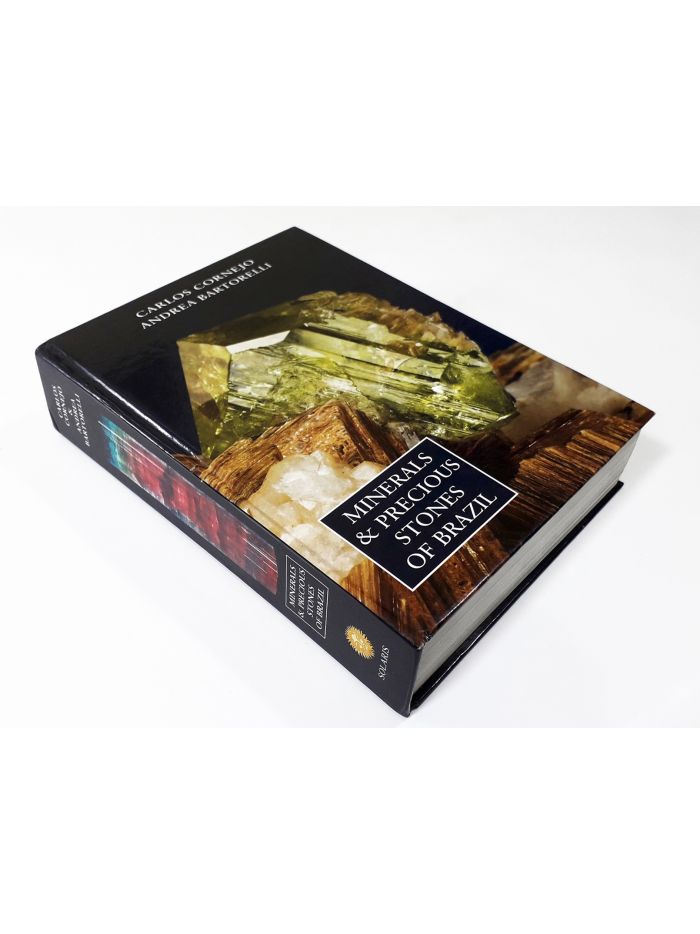Livro Minerals & Precious Stones Of Brazil - Cornejo
Livro Minerals & Precious Stones Of Brazil - Cornejo
This book describes Brazilian minerals, masterpieces of nature, which endowed our subsoil with incomparable wealth of variety and quality. The authors opted to place emphasis on the history of mineralogy in Brazil, closely linked with the history of Brazilian mining, which has been characterized by a series of superlatives.
|
Título do livro |
Minerals & Precious Stones of Brazil |
|
Autor |
Carlos Cornejo & Andrea Bartorelli |
|
Idioma |
Inglês |
|
Editora do livro |
Solaris Edições Culturais |
Outras características
- Gênero do livro: História,Mineralogia,Gemologia,Geologia,Colecionismo,Pedras preciosas
- Tipo de narração: Histórico, recreativa.
- ISBN: 9788589820080
Descrição
Em inglês (para a versão em português procure nosso anúncio respectivo: https://produto.mercadolivre.com.br/MLB-1640293474-livro-minerais-e-pedras-preciosas-ed-2014-novo-com-index-_JM?quantity=1#position=1&type=item&tracking_id=0dfa2808-0188-49c2-b7f4-84ff10763e3d).
Hardcover book with 712 pages and 1,200 colorful photographs,
engravings and drawings. Its closed format is 24x18 centimeters.
New, sealed!
Edition of 2014, with index!
The book Minerals & Precious Stones of Brazil is unique in its kind and its first edition was afforded with the sponsorship of Vale by means of the Federal Law of Cultural Incentive. It presents a vast historical and iconographic panorama of the national production of minerals and precious stones, with chapters dedicated to Indian lithic art of Brazil, the beginning of mineralogy in the Country recorded by European travelers, naturalists and mineralogists, as well as cabinets of curiosities, mineralogical museums, private collections and collections of the Court of the Imperial Family, emphasizing the Museu Nacional, the Museu Ciências da Terra, the Museu de Ciência e Técnica of the Escola de Minas of Ouro Preto and the Museu de Geociências of the Universidade of São Paulo.
Still regarding the historical aspect, the work broaches the description of new minerals in Brazil and the gold and diamond cycles, with pictures of great interest drawn by travelers, as well as splendid sceneries during the gold rush of Serra Pelada in recent decades, registering for the first time in a book the biggest gold nuggets still preserved in the World, which belong to the collection of the Museu de Valores of the Banco Central, in Brasilia.
The book depicts some of the most beautiful, amazing and valuable brazilian specimens of emerald, aquamarine, heliodore, morganite, tourmaline, garnet, topaz, euclase, amethyst and diamond, many of them unique and that render Brazil one of the World’s major producers of gems.
According to Luiz Alberto Dias Menezes Filho, in the foreword of the book:
This book describes Brazilian minerals, masterpieces of nature, which endowed our subsoil with incomparable wealth of variety and quality. The authors opted to place emphasis on the history of mineralogy in Brazil, closely linked with the history of Brazilian mining, which has been characterized by a series of superlatives:
Brazil was leading world producer of gold and of diamonds between the mid-18th century and the mid-19th century. At the present time, it is the leading world producer of iron ore, tin and niobium, and an important producer of manganese, aluminum, silicon, tantalum, rare earths, graphite, magnesite and countless other ores.
In the field of collection and gemological minerals, Brazil is the leading world producer of tourmaline (of all colors), of quartz (colorless, rutilated, amethyst and agate), of beryl (aquamarine, morganite and heliodore, and the second ranking world producer of emerald), of topaz (imperial, blue and colorless), alexandrite, euclase, phenakite and many others.
On behalf of Brazilian mineral collectors, who contributed most of the photos, I would like to thank the company VALE for the pioneer and notable initiative of sponsoring the publication of this book, and CPRM for the first updated reprint, which should contribute to portray the extremely rich history of Brazilian mining, with an emphasis on small pegmatite mining ventures, factories of dreams and of illusions, which do not only provide conditions for subsistence and progress in some of the poorest regions of Brazil, but also enabled the recovery of these spectacular minerals, generating important funds for the Nation, as well as extremely valuable scientific knowledge.
According to Carlos Cornejo, one of the authors:
This book formed gradually like a crystal, incorporating, page by page, extraordinary mineral treasures and true masterpieces of Nature. To produce this paper museum, we went around mines and “garimpos”, visited museums and libraries, and came into contact with collectors, scientists, miners and “garimpeiros”.
Brazil is one of the greatest producers of minerals of economic importance, precious stones and mineralogical collection specimens in the world, which explains the relevance of a publication that describes the amazing wealth of the mineral kingdom in the country.
We wished to highlight lithic art and the use of minerals by indigenous peoples, the history of great discoveries of noble metals and gemstone minerals, and the excellent, sometimes unique specimens, that exist in museums and private collections. All illustrated with refined photographic technique, justifying the publication of a book that reunites images of the marvels that have already been found in Brazilian subsoil, faithfully reproducing their habits, crystallization, color and luster, besides focusing on aspects of their extraction, with abundant documentation portraying the landscape and the people from the back country of Brazil, from the gold claims of the Amazon, passing through the diamondiferous and precious stone producing regions of the Northeast and Southeast, to the agate and amethyst claims of the tablelands of Rio Grande do Sul.
The book covers aspects related essentially to mineral production and dates back to colonial times, gathering reports from travelers and naturalists, besides reproductions of prints produced by notable illustrators, with important historical images forming part of this documentation.
We emphasize that the book also addresses minerals as subjects of cultural interest, instilling in readers the perception of precious stones and minerals as natural aesthetic products, to be protected so that future generations can contemplate this irreplaceable legacy of Nature.
According to Andrea Bartorelli, the other author:
In the start of the editorial project of this book we were surprised by the enthusiastic support of friends, collectors, scholars, technicians, miners, prospectors, claim owners and museums, which ceaselessly flowed in with specimens, photographs, documents, texts, suggestions, corrections. They kindly put at our disposition their collections, showcases and safes, making them available to be photographed and documented with all the dedication they required. Their contributions were such that the book grew bulkier in an unexpected manner.
The minerals are reproduced in the photographs as they were found in Nature, having not been submitted to any process of cutting or polishing, except in the case of agates and cut stones.
We have also reunited the history of emerald, gold and diamond cycles, as well as accounts of the great discoveries or “bamburros” and their protagonists, besides reports on modern mineral discoveries, such as that of the iron of Serra dos Carajás.
One of the most highly esteemed Brazilians dedicated to mineralogy was José Bonifácio de Andrada e Silva, the Patriarch of Independence and the greatest mineralogist and collector of Brazil of his time. Members of the Imperial Family also dedicated to interesting collections, such as the Empress Leopoldina, the Emperor Dom Pedro II and specially Prince Dom Pedro Augusto de Saxe-Coburgo-Gotha e Bragança.
With this publication we hope to instill the appreciation and the preservation of specimens of the various mineral species, a unique and rare legacy, comparable to the most valuable art masterpieces. If this book awakens interest in Brazil’s precious and amazing mineralogical and cultural heritage, it will justify the efforts of all those who collaborated with us for its achievement, an enjoyable task that provided us with the opportunity to come into contact with all the people passionate about the wonderful mineral world.


